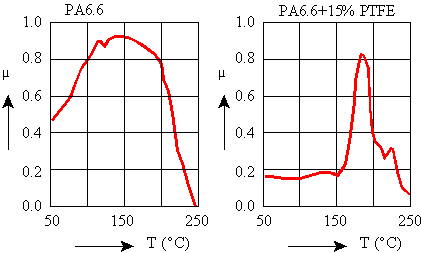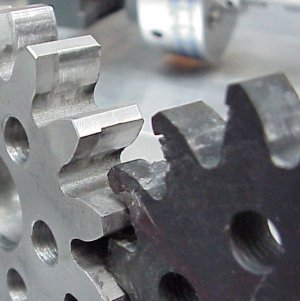|
High performance polymers |
|
|
 Classification of high performance polymers (compounds).
Classification of high performance polymers (compounds).
 Internal lubricants and reinforcements
Internal lubricants and reinforcements
 Listing of "high performance" and "engineering"
polymers
Listing of "high performance" and "engineering"
polymers
 Physical
properties
Physical
properties
 Criteria for material selection and combinations.
Criteria for material selection and combinations.
 Temperature effects
Temperature effects
 Closure
Closure
|
|
|
 Classification of high performance
polymers (compounds):
Classification of high performance
polymers (compounds):
- hardwearing.
- high temperature resistant and high mechanical strength.
High Performance polymers have a thermal resistance
>150°C. Examples of hard wearing high
performance polymers are:
- PEEK - Polyetheretherketon
- PES - Polyethersulfon
- PI - Polyimide
Engineering polymers are classified by a temperature resistance
within 100°C and 150°C. Examples of engineering polymers are
- PA6.6 - Polyamide
- PA6 G - Cast Polyamide (LFX with AF lubricant)
- POM - Poly Oxy Methylene (acetal)
- PETP - Poly Ethylene Terephtalate (PET)
- UHMWPE - Ultra High Molecular Weight Polyethylene
- PBTP -
Standard polymers have a thermal resistance below <100°C
and less suitable for sliding / rolling surfaces. Examples of these
polymers are:
- HDPE - High Density Poly Ethilene
- ABS
- PMMA
- PVC
|
|
|
|
 Most high performance polymers (compounds) are reinforced
by
Most high performance polymers (compounds) are reinforced
by
fibres or/and filled with internal anti
friction lubricants.
Traditional reinforcements and internal AF lubricants are:
- PTFE
- Silicone oil
- Graphite
- MoS2
- Aramide
- Carbon fibre
- Glass fibre
- Alloy- / blend technology e.g. HWPE
Effects of reinforcements and internal AF lubricants are:
- PTFE reduces the coefficient of friction. Is effective at high
pressure. Creates a PTFE film between the compound and the
counterface.
- Silicone oil reduces coefficients of friction. Migrates to the
wear surface. Offers lubricity at start up and at high speeds. Not
effective at high surface pressures.
- PTFE with silicone oil improves tribological properties over a
broad velocity range. Excellent for oscillatory motion (less
"slip stick"). Considerable improvement in LPV at high
speeds.
- Molybdenum Sulphide (MoS2) enhance the crystallization of PA
(surface hardening). Reduction of "slip stick" effect.
Moderate improvement of wear factor.
- Graphite Powder as boundary lubricant often used in aqueous
moisture environment.
- Aramide for improvement of the wear factor. Low counter face wear
against soft metal, e.g. Cu, Al. Low plastic-on-plastic wear
(identical partner). Low noise. Low abrasive wear. Dimensional
stability.
- Carbon fibres improve mechanical performance. Results in higher
LPV-value and in reduction of wear factor. Reduce wear of both
surface and mating surface as compared to glass fibres. Statically
dissipate / conductive.
- Glass fibres improve mechanical properties. Higher LPV-value.
Reduction of wear factor. Increase wear of mating surface.
|
|
|
 The listing below is restricted to polymers
that are "well" described by industrial suppliers. Both the
physical properties as well as the composition is described.
Unfortunately, tribology data is still limited.
The listing below is restricted to polymers
that are "well" described by industrial suppliers. Both the
physical properties as well as the composition is described.
Unfortunately, tribology data is still limited.
Listing of "high performance" commercial polymers
- PEEK
- PEEK-BG (zwart), Carbon Fibre, PTFE and Graphite
- PEEK-GF30, 30% Glass Fibre
- PEEK-CA30, 30% Carbon Fibre (not listed)
- PPS+, fibre reinforced and solid AF lubricants
- PES
- PI+15% Graphite
Listing of "engineering" commercial polymers
- PA6.6, Polyamide (Nylon)
- PA6.6 GF30, 30% Glass Fibre reinforced
- POM C, Copolymer, Acetal
- POM H, Homopolymer, Acetal, Delrin
- POM H-TF, Homopolymer + Teflon
- PETP
- PETP TX
|
|
|
|
 Criteria for material selection
Criteria for material selection
- wear factor
- dynamic and static coefficients of friction
- limiting PV value
- counter face wear
- material costs
Material combinations and consequences.
- polymer - metal
- polymer - polymer
Internal lubricated compounds versus metal
- Up to 90% of frictional heating is conducted by the metal part.
- fibre reinforced polymers wear the metal surface.
Plastics against plastics
- Dissimilar polymers results in a reduction of the static
coefficient of friction.
- Use of PTFE lubrication dramatically reduces wear rates in both
similar and dissimilar resins.
- Against a fibre reinforced compound, the mating material should
contain PTFE lubrication
- Aramide compounds have excellent wear characteristics.
|

